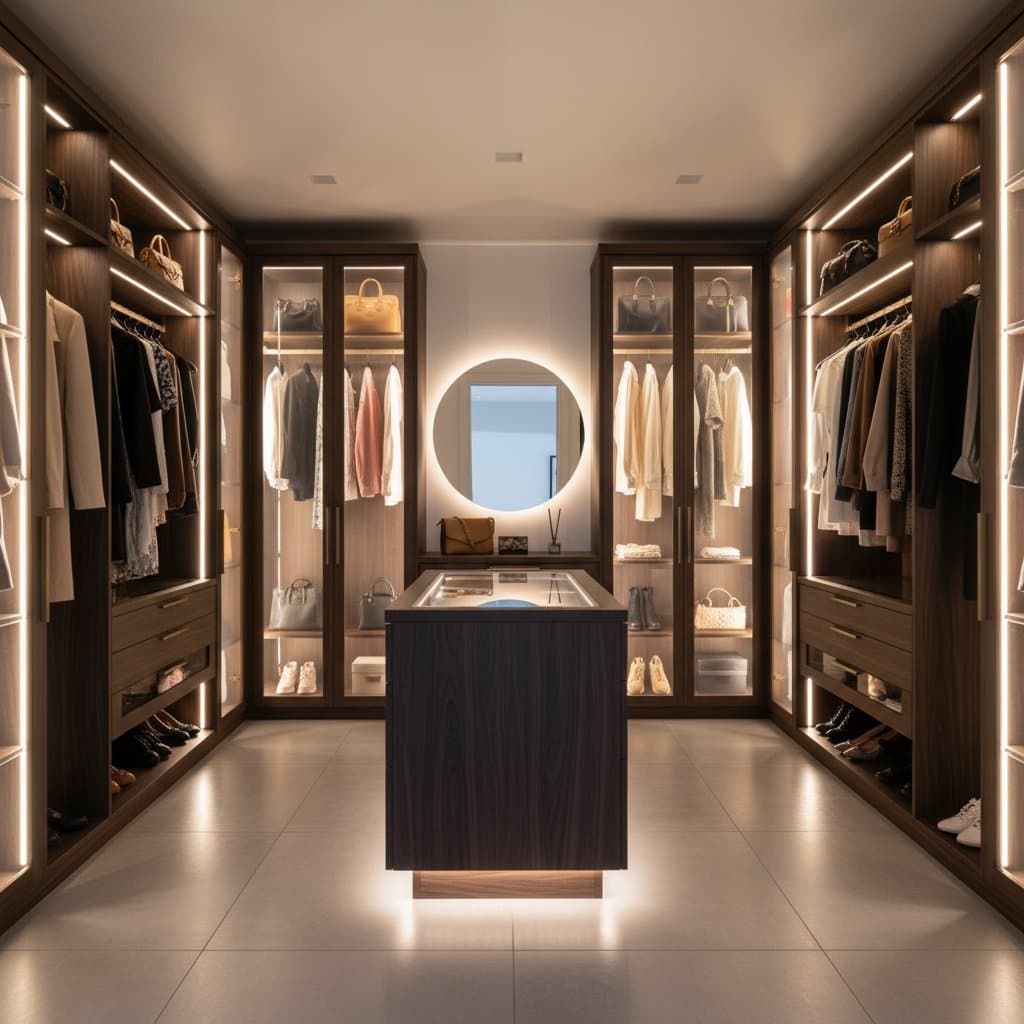Integrating Lighting into Closet Design
Designers position closet lighting as an essential element of interior planning. This approach shapes daily routines and elevates the space beyond mere storage.
Thoughtful illumination highlights architectural details and supports user needs. It transforms a functional area into one that promotes efficiency and enjoyment.
Selecting Materials and Finishes for Optimal Effect
Lighting interacts closely with closet surfaces, influencing visual appeal and usability. Proper material choices ensure light distribution remains balanced and inviting.
- Matte cabinet finishes minimize reflections for a serene environment.
- Brushed brass or bronze accents introduce subtle warmth.
- Natural wood elements complement lower color temperatures.
- Glass shelves enable diffused light layers for depth.
Designer Rachel Lin states, "The best lighting respects the materials around it. You want the light to enhance texture, not fight it." She suggests 2700K to 3000K for wood and 3500K for lacquer or mirrors to refine the ambiance.
Advancing with Motion and Sensor Features
Motion sensors extend beyond basic utility, offering refined automation in premium setups. Lights respond to entry, adjust based on activity, and promote energy savings.
Infrared or ultrasonic sensors capture fine movements, such as reaching for items. Ambient sensors balance natural and artificial light to avoid excess illumination.
Homeowner Maria Cruz shares, "It feels alive now. I open the door, and the light greets me. I never have to fumble for a switch again." This effortless operation sets the benchmark for contemporary luxury.
Achieving Luxury on Various Budgets
Premium brands like Häfele, Lutron, and Kichler offer high-end solutions, yet accessible alternatives exist. Scalable choices provide comparable sophistication without high costs.
- Rechargeable motion bars begin below fifty dollars.
- Tunable plug-in LED rods fit existing setups.
- Magnetic tracks enable reconfiguration sans wiring.
Renters benefit from adhesive wireless options for non-invasive upgrades. Layer budget sensors with targeted accents to replicate integrated systems.
Interior designer Eli Sanders recommends, "Upgrade the lighting near your most used areas first." Focus on a jewelry drawer or shoe shelf to refresh the entire area.
Enhancing Organization Through Illumination
Effective lighting clarifies contents, streamlining organization tasks. Vertical strips reveal stacked items, while drawer lights expose accessories.
Overhead rods ensure uniform garment exposure, reducing shadows and wear. This visibility accelerates outfit selection by showcasing colors and textures accurately.
Designer Lin observes, "Good lighting lets you see your wardrobe as a collection, not a pile of options. It makes dressing intuitive." Such clarity fosters confidence and reduces daily stress.
Prioritizing Sustainability in Modern Systems
Efficiency defines today's luxury lighting, with LEDs using low energy and durable components. Recyclable aluminum and low-VOC finishes support eco-conscious choices.
Modular designs allow repairs over replacements. Automated controls dim or deactivate unused lights, optimizing consumption.
This integration of aesthetics and responsibility aligns with evolving home standards, balancing personal luxury with planetary care.
Essential Features in Premium Installations
Current systems incorporate innovative elements for seamless performance.
- Slimline fixtures at 0.4 inches thick integrate into shelves or drawers.
- Wireless dimmers via Bluetooth or Wi-Fi eliminate wiring needs.
- CRI ratings of 95 or higher preserve accurate clothing hues.
- Diffused covers reduce glare while sustaining output.
- Custom channels hide cables for clean lines.
These pair with storage solutions:
- Motion-triggered drawer illumination.
- LED rods serving as hanging rails.
- Edge lighting for shelf displays.
Affordable options include:
- Battery-operated under-shelf motion lights.
- Touch-dimmable magnetic LED bars.
- Motion sensors with standard smart bulbs.
Such specifics create upscale effects affordably.
The Broader Impact on Daily Home Life
Luxury closet lighting reflects a cultural evolution toward experiential homes. Functionality yields to emotional resonance, fostering identity and ease.
A morning entry into balanced light instills composure. This subtle enhancement influences mindset, underscoring the value of intentional spaces.
Implementing Upgrades in Your Space
Begin with a single closet zone, such as a dim shoe area or outfit section. Install a motion strip or LED bar to assess the shift.
Select 3000K for natural warmth or 3500K for clarity. Incorporate dimmers to adjust for time or mood.
In expansive closets, layer overhead and side lighting, including behind mirrors. Test fabric rendering under potential fixtures for best results.
Personalizing Your Lighting Setup
Tailor illumination to preferences, from vibrant displays to ambient glows. Adapt to lifestyle: sensors for frequent zones, dimmables for variable hours.
Portable adhesives suit renters; integrated fixtures benefit owners. Ensure placements align with habits for intuitive use.
Embracing the Enhanced Routine
A illuminated closet alters interactions with possessions, introducing precision and tranquility. It embodies self-care through deliberate design.
Start modestly or pursue full automation; the outcome remains a space attuned to your needs, amplifying both utility and satisfaction.
